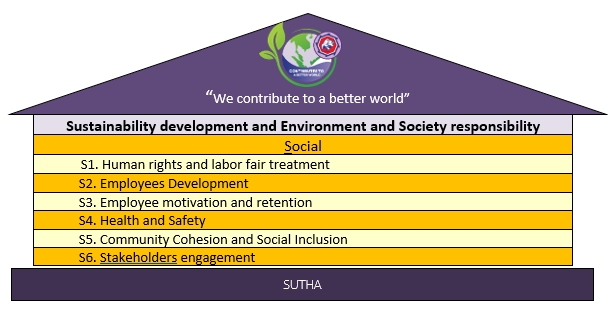
 SUTHA's social operations
SUTHA's social operations
Golden Lime Public Company Limited (SUTHA) is committed to developing its business operations to be in line with the sustainable development framework and has applied guidelines in accordance with the sustainability assessment criteria of listed companies on the stock exchange and the policy framework according to the expectations of key stakeholder groups in order to Framework for guidelines for setting directions Development drives business sustainably with responsibility towards society, the environment and stakeholders. The " Policy Framework for Sustainable Development and Environmental and Social Responsibility_ESG Policy" and Social aspect is as follows.

S1. Human rights and Fair Labor Practices
Principles
The responsibility to respect human rights is a global standard of expected conduct for all business enterprises wherever they operate. Respecting human rights is part of good business practice and risk management. Fair treatment in the workplace refers to equality and fairness as it relates to financial compensation, benefits, disability accommodations, vacation time, and paid leave. SUTHA has improved and reinforced the human rights management guideline in alignment with the sustainability management.
Guidelines
- A human rights policy is established that covers employees and stakeholders of the organization.
- Employees/workers are treated in accordance with human rights policy, such as hiring people with disabilities, negotiations regarding welfare through representatives of the Welfare Committee, etc.
- Disclosure of Human Rights Due Diligence
- identify, prevent, mitigate, and account for how we address their adverse human rights impacts, corrective action, and remediation
S2. Employee development
Principles
Developing employee potential by providing continuous learning and individual development plans to motivate employee inclusion and engagement to take part in business development.
Guidelines
- An employee development plan that outlines that person's professional growth and training needs
- Training plans in response to the Companys goal
- Training record for evaluation
S3. Motivation and retention of employees
Principles
Managing for employee retention involves strategic actions to keep employees motivated and focused so they elect to remain employed and fully productive for the benefit of the organization
Guidelines
- Implement performance appraisal in compensation
- Conduct both employee satisfaction and employee engagement surveys
- Turn survey results to boost engagement and reduce attrition.
- Communicate retention performance as a commitment to employee care improvement.
S4. Health and safety at work
Principles
The Company implements ISO 45001 Occupational Health and Safety Management System to improve employee morale, reduce workplace accidents to zero , and demonstrate a commitment to safety, which collectively lead to increased productivity and business growth.
Guidelines
- Managing to ensure healthy and work safety in an appropriate environment.
- Establish and review objectives, target of occupational health, safety and workplace environment
- Maintain standardized Health and safety of employees.
- Safety assessment to contractors/partners
- Prevention and risk mitigation
- Safety record and safety investigation Lost Time Injury Frequency Rate: LTIFR / Lost Time Incident Rate: LTIR, Absent Rate: AR
- Training on safety awareness
- Safe work practices

S5. Community and society engagement
Principles
Community engagement is key to the success of sustainability development strategy as it assists businesses and employees to understand and embrace community, authorities, and agencies perspectives by involving communities, community, authorities, and agencies for continuous feedback from such stakeholders for smooth corporation with local authorities.
Guidelines
- Community and society engagement to obtain their concern regarding business Operations for impact mitigation
- Projects / Initiatives contribute to community development or solution through business processes by setting operating strategies with the community or jointly solving social problems as well as following up on results and benefits that the company receives in terms of quantity/value/economic returns such as income, profits, and expenses that can be reduced or a reduced level of risk or quantifiable social benefits/returns to the community or benefits to society in terms of process results (Output) or final results (Outcome)

S6. Stakeholder Involvement and Participation
Principles
Stakeholder engagement provides opportunities to further align practices with societal needs and expectations, helping to drive long-term sustainability. Engaging stakeholders in the dialogue to find out what social and environmental issues matter most to them will improve decision-making and accountability.
Guidelines
- The process includes:
1.1) Establish a policy to include and categorize all stakeholders
1.2) Prioritize and specify activities for each group of stakeholders including reporting to the board - The management adopts the framework from the Board, follows up performance and involves employees to participate in proposing ideas for activities or projects.
| Name | : | Performance for Sustainable development and Corporate Responsibility |
| Size | : | 9.06 MB |
| Type | : |





